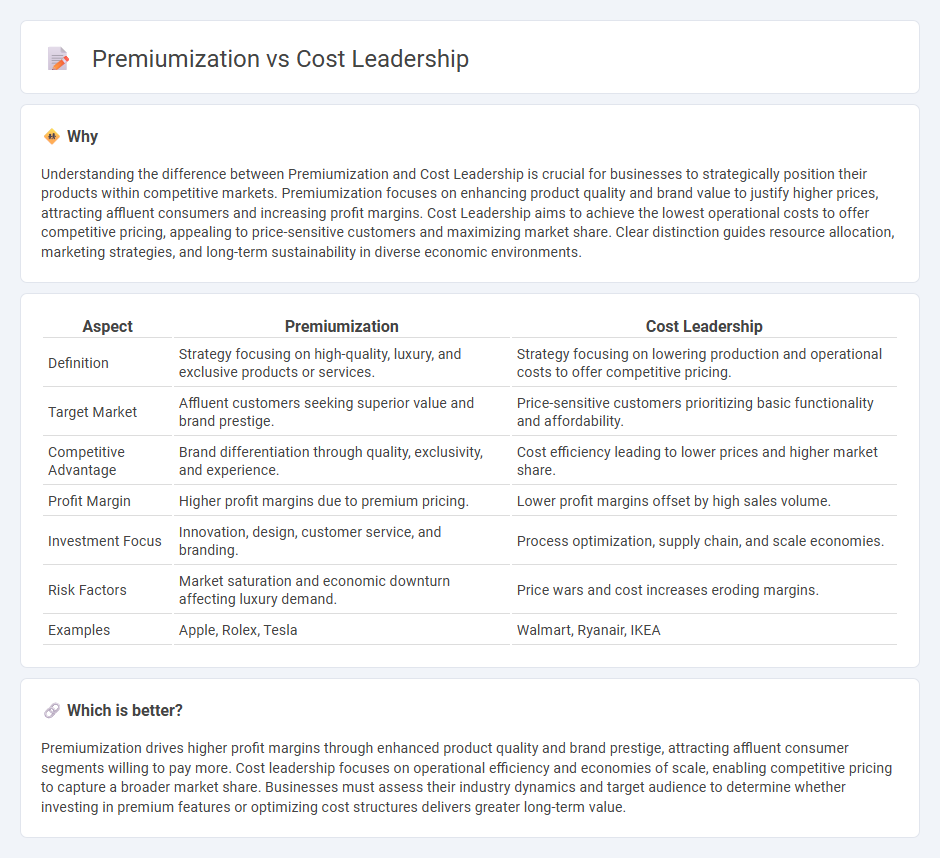
Premiumization focuses on offering high-quality, exclusive products that command higher prices through superior value and brand prestige, targeting affluent consumers. Cost leadership aims to achieve the lowest production and operational costs to provide affordable goods and services, appealing broadly to price-sensitive markets. Explore how businesses balance these strategies to optimize profitability and market positioning.
Why it is important
Understanding the difference between Premiumization and Cost Leadership is crucial for businesses to strategically position their products within competitive markets. Premiumization focuses on enhancing product quality and brand value to justify higher prices, attracting affluent consumers and increasing profit margins. Cost Leadership aims to achieve the lowest operational costs to offer competitive pricing, appealing to price-sensitive customers and maximizing market share. Clear distinction guides resource allocation, marketing strategies, and long-term sustainability in diverse economic environments.
Comparison Table
| Aspect | Premiumization | Cost Leadership |
|---|---|---|
| Definition | Strategy focusing on high-quality, luxury, and exclusive products or services. | Strategy focusing on lowering production and operational costs to offer competitive pricing. |
| Target Market | Affluent customers seeking superior value and brand prestige. | Price-sensitive customers prioritizing basic functionality and affordability. |
| Competitive Advantage | Brand differentiation through quality, exclusivity, and experience. | Cost efficiency leading to lower prices and higher market share. |
| Profit Margin | Higher profit margins due to premium pricing. | Lower profit margins offset by high sales volume. |
| Investment Focus | Innovation, design, customer service, and branding. | Process optimization, supply chain, and scale economies. |
| Risk Factors | Market saturation and economic downturn affecting luxury demand. | Price wars and cost increases eroding margins. |
| Examples | Apple, Rolex, Tesla | Walmart, Ryanair, IKEA |
Which is better?
Premiumization drives higher profit margins through enhanced product quality and brand prestige, attracting affluent consumer segments willing to pay more. Cost leadership focuses on operational efficiency and economies of scale, enabling competitive pricing to capture a broader market share. Businesses must assess their industry dynamics and target audience to determine whether investing in premium features or optimizing cost structures delivers greater long-term value.
Connection
Premiumization and cost leadership intersect as strategic approaches businesses use to optimize market positioning and profitability. Companies pursuing premiumization focus on enhancing product quality and brand perception to justify higher prices, while cost leadership emphasizes operational efficiency to offer competitive pricing. Balancing these strategies involves delivering superior value at controlled costs, enabling firms to capture diverse customer segments and sustain long-term economic growth.
Key Terms
Pricing strategy
Cost leadership emphasizes competitive pricing by minimizing production and operational expenses to offer products at the lowest possible price point, attracting price-sensitive customers. Premiumization relies on value-based pricing strategies, targeting niche markets willing to pay higher prices for superior quality, exclusivity, and enhanced brand experience. Discover how to balance cost efficiency and premium appeal to optimize your pricing strategy effectively.
Market segmentation
Cost leadership targets price-sensitive market segments by offering products at competitive prices, maximizing market share through economies of scale and operational efficiency. Premiumization appeals to affluent consumers seeking high-quality, exclusive products, emphasizing brand prestige and advanced features to justify higher prices. Explore how businesses balance these strategies to effectively capture diverse consumer groups.
Value proposition
Cost leadership emphasizes delivering products or services at the lowest possible price by optimizing operational efficiency and reducing costs, targeting price-sensitive customers. Premiumization focuses on enhancing product quality, brand prestige, and customer experience to justify higher prices and attract discerning consumers seeking superior value. Explore the nuances of value proposition strategies to better align your business goals and market positioning.
Source and External Links
Cost leadership - Wikipedia - Cost leadership is a business strategy aimed at gaining competitive advantage by having the lowest operational costs in the industry, often achieved through efficiency, scale, and operational controls; it allows companies to offer lower prices or higher profitability than competitors, exemplified by firms like Walmart.
Cost Leadership Strategy: Pros, Cons and Implementation - To implement cost leadership, businesses must assess industry structure, improve operational efficiency, optimize supply chains, perform ongoing cost analysis, and set competitive pricing aligned with their low-cost position.
What is Cost Leadership Strategy? - Cost leadership involves creating efficient processes to deliver products or services at the lowest cost in a market segment, which can then be leveraged to undercut competitors or increase profitability, requiring strong organizational leadership to maintain sustainable low costs.
 dowidth.com
dowidth.com